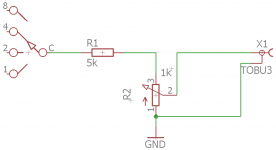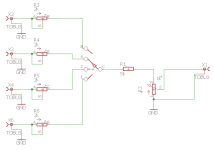Thanks. Some very expensive knobs are composed of discrete resistors. Is this really necessary? Will a conventional potentiometer suffice?
Get it working with a cheap vol pot. The plastic film type are quite reliable.
You can experiment later with a fixed pair of resistors that give the same volume as your preferred setting of the vol pot.
Then you can decide on that comparison if fixed resistor volume adjustement gives better sound quality than the vol pot. That is when you get the chance to spend your money.
You can experiment later with a fixed pair of resistors that give the same volume as your preferred setting of the vol pot.
Then you can decide on that comparison if fixed resistor volume adjustement gives better sound quality than the vol pot. That is when you get the chance to spend your money.
Thanks. Some very expensive knobs are composed of discrete resistors. Is this really necessary? Will a conventional potentiometer suffice?
These are actually "potmeters" built out of a rotary switch with a lot of positions. The advantage is that these are more accurate, especially at the extreem ends of the "potmeter" (almost at 0 / almost at their max).
I personal wouldn't worry to much about it and use a regular potmeter. The one I used in my initial built was a conductive plastic from Bourns. Just try to avoid the cheaper carbon potmeters.
As for value, I wouldn't use a value too high; something in the likes of 5k or 10k.
http://www.mouser.be/ProductDetail/...=sGAEpiMZZMtC25l1F4XBUzRpED6aMRJcD56BVfXb/Hg=The one I used in my initial built was a conductive plastic from Bourns.
Thanks very much Andrew & Delange.
Am I right in thinking of volume control as a voltage divider? And so the magnitude of the resistor pair is not critical, just the ratio? But higher resistance values introduce more noise? And lower values (than 10k) would impose too much load on the source?
I also want to fit (internally) adjustable attenuation for each input. More pots I guess or else switches with simple 3dB, 6dB, 9dB selection (internally like dipswitches or jumpers).
Pops.
Am I right in thinking of volume control as a voltage divider? And so the magnitude of the resistor pair is not critical, just the ratio? But higher resistance values introduce more noise? And lower values (than 10k) would impose too much load on the source?
I also want to fit (internally) adjustable attenuation for each input. More pots I guess or else switches with simple 3dB, 6dB, 9dB selection (internally like dipswitches or jumpers).
Pops.
Am I right in thinking of volume control as a voltage divider?
Yes
But higher resistance values introduce more noise?
Correct
And lower values (than 10k) would impose too much load on the source?
Not really. Any source should be able to drive loads of 5k with ease and without any issues.
I also want to fit (internally) adjustable attenuation for each input. More pots I guess or else switches with simple 3dB, 6dB, 9dB selection (internally like dipswitches or jumpers).
Pots are the easiest and most flexible. But you could also use attenuators.
Oh, and I would suggest using linear potmeters instead of logarithmic. The latter is not fit for volume control.
Interesting... why? We hear in a log scale so it's most useful to have log volume control.Oh, and I would suggest using linear potmeters instead of logarithmic. The latter is not fit for volume control.
Is there some difference in the technology between linear & log pots?
The Bourns part you linked is available with linear taper and 'audio' taper which presumably is logarithmic.
Last edited:
Interesting... why? We hear in a log scale so it's most useful to have log volume control.
Is there some difference in the technology between linear & log pots?
The slope and our hearing profile is not relevant.
You will be disappointed about their behavior: up until about 3/4 quarter turn there will be very little change in volume. But the majority of the volume control happens in the last 3/4 quarter turns.
Hmmm maybe the ideal position of the volume can be adjusted using fixed attenuation internally. With the high power and sensitivity of the Q-Watt I think a fair wad of fixed attenuation will be needed for 2V sources. Will need to lose about 10dB before even thinking about volume control. This should increase the usable range of the potentiometer. Or am I talking rubbish?
you can experiment with a linear track vol pot but I think you will be very disapponted in the way the volume appears to change with rotation.
I recommend a log law vol pot first.
Then see if you can live with that and what it does not do perfectly.
BTW, noise added by a vol pot below 100k is not audible in normal sensitivity systems. Ignore added noise from vol pot unless you have very sensitive speaker combined with high gain amplifier.
I recommend a log law vol pot first.
Then see if you can live with that and what it does not do perfectly.
BTW, noise added by a vol pot below 100k is not audible in normal sensitivity systems. Ignore added noise from vol pot unless you have very sensitive speaker combined with high gain amplifier.
Hmmm maybe the ideal position of the volume can be adjusted using fixed attenuation internally. With the high power and sensitivity of the Q-Watt I think a fair wad of fixed attenuation will be needed for 2V sources. Will need to lose about 10dB before even thinking about volume control. This should increase the usable range of the potentiometer. Or am I talking rubbish?
There is indeed some sense in that: something like the attached picture will give you volume control and about 14 dB attenuation.
The potmeter could be something like this one
Attachments
Mmm I like that Delange. You have just shown one ground. Actually each source RCA connection will have its own signal ground. Do I need to switch in the appropriate signal ground too? I think you showed just one switch for the 'signal' wire.
Also some sources are stronger than others so I would split the fixed resistor into one per source channel upstream of the switch.
Pops.
Also some sources are stronger than others so I would split the fixed resistor into one per source channel upstream of the switch.
Pops.
Mmm I like that Delange. You have just shown one ground. Actually each source RCA connection will have its own signal ground. Do I need to switch in the appropriate signal ground too? I think you showed just one switch for the 'signal' wire.
Also some sources are stronger than others so I would split the fixed resistor into one per source channel upstream of the switch.
Pops.
I posted a "mono" version; so you need a double pole switch and a dual gang potmeter for the volume pot. I'm not a fan of switching the ground signals.
I would do it as in the attached picture. Again this is a mono version but it works the same in stereo.
If you are worried about the the differences in the different sources you could add potmeters in series in the input sides. I added 2k pots but you can increase them to say 5k if you want more attenuation.
Attachments
14dB is 1/5th, but 5k in series with 1k volpot gives 1/6th = -15.56dBThere is indeed some sense in that: something like the attached picture will give you volume control and about 14 dB attenuation.
The potmeter could be something like this one
Nearest resistor to 5k is 5k1 in E24 range, giving -15.71dB
3k9 gives -13.8dB
Last edited:
Useful Cct delange, thanks.
Although i have preferred to use the linear pot you suggested to use in an earlier post.
3310H-001-103L - BOURNS - Rotary Potentiometer, Sealed Panel Control, 10 kohm, 250 mW, ± 20%, 3310H Series, 1 Turns, Linear | Farnell element14
or
3310H-001-103L | Bourns 3310H-001 Series Conductive Plastic Potentiometer with a 3.17 mm Dia. Shaft, 10k?, ±20%, 0.25W, ±1000ppm/°C | Bourns
Knowing as a fellow constructor of the Q-Watt, you have tried and tested these things and are more than happy with the results.
Thankfully yours and my life and our Q-Watt projects were put into our hands when the project began, I'm very much alive as you are, and our Q-Watts are working fantastic!
Although i have preferred to use the linear pot you suggested to use in an earlier post.
3310H-001-103L - BOURNS - Rotary Potentiometer, Sealed Panel Control, 10 kohm, 250 mW, ± 20%, 3310H Series, 1 Turns, Linear | Farnell element14
or
3310H-001-103L | Bourns 3310H-001 Series Conductive Plastic Potentiometer with a 3.17 mm Dia. Shaft, 10k?, ±20%, 0.25W, ±1000ppm/°C | Bourns
Knowing as a fellow constructor of the Q-Watt, you have tried and tested these things and are more than happy with the results.
Thankfully yours and my life and our Q-Watt projects were put into our hands when the project began, I'm very much alive as you are, and our Q-Watts are working fantastic!
Hi guys. See Rod Elliott's proposed improved volume control, figure 8 in the link below:
Potentiometers (Beginners' Guide to Pots)
This allows you to reclaim more of the pot travel for higher volumes instead of wasting 30 degrees or more below -30dB.
Potentiometers (Beginners' Guide to Pots)
This allows you to reclaim more of the pot travel for higher volumes instead of wasting 30 degrees or more below -30dB.
True Delange, we're waiting for Mr Popchops to give us some news.
However, if any problem pops (excuse the pun) up your fellow constructors are here to help.
As for my Q-watt, I've had it running beautifully non stop for over a week.
Just the remaining labelling to do and the front led to fit!
I gone back now to my Elektor Preamplifier 2012, got all the parts etc etc., just need to start putting it all together!
Once finished ill use it with the Q-Watt
However, if any problem pops (excuse the pun) up your fellow constructors are here to help.
As for my Q-watt, I've had it running beautifully non stop for over a week.
Just the remaining labelling to do and the front led to fit!
I gone back now to my Elektor Preamplifier 2012, got all the parts etc etc., just need to start putting it all together!
Once finished ill use it with the Q-Watt
Last edited:
Hey Pops, just wondering how your Q-Watts are coming along. Are they up and running?
Hi folks. It's a family wedding weekend then I'm away with work most of next week. Not much time for the amp :-/
A friend drilled and tapped 4x M4 holes to mount my PCB brackets but something went wrong. The thread was not very good. So instead he has glued in 4x M4 threaded studs which is just as good.
I'm working on the passive preamp in parallel. Kevin, the boss of HiRes Technologies (HRT) tells me that my favourite source (DAC) has output impedance a bit higher than 250 Ohms. He recommended a 1K potentiometer. I need to figure if this is a generically acceptable figure for typical sources. Gut is telling me to stick with 10K. If I have a 50K pot with 11K in parallel from the wiper to ground, does this give me 9K Ohms input impedance (for the vol control box) at max vol?
Should get my 'sinks back this week and then there's not much stopping me from powering up the PCB. Slow going.
Pops.
Last edited:
- Home
- Amplifiers
- Chip Amps
- My Q-Watt project

